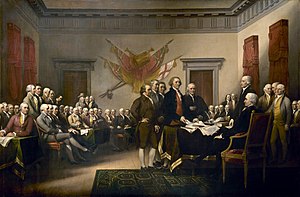
Dr. John Witherspoon (February 5, 1723 – November 15, 1794), was a signer of the United States Declaration of Independence as a representative of New Jersey. He was the only clergyman to sign the Declaration.

Dr. John Witherspoon (February 5, 1723 – November 15, 1794), was a signer of the United States Declaration of Independence as a representative of New Jersey. He was the only clergyman to sign the Declaration.
He was born in Gifford, Haddingtonshire, Scotland, attended the Haddington Grammar School, and obtained a Master of Arts at the University of Edinburgh in 1739. He went on to divinity school, afterwards becoming a Church of Scotland (presbyterian) minister at Beith, Ayrshire, where he married and wrote three well-known works on theology. He was awarded a Doctorate of Divinity from the University of St Andrews, Fife. During the Jacobite rising of 1745, he was briefly imprisoned at Doune Castle, Doune, Stirling, which had a long-term impact on his health.
At the urging of Benjamin Rush and Richard Stockton, who he met whilst living in the town of Paisley, Scotland [1] he finally accepted another invitation (he had turned it down in 1766) to become President of the Presbyterian College of New Jersey in Princeton, and he and his wife emigrated to New Jersey in 1768, at the age of 45, where he took up the position of 6th President of the college which was later to become Princeton University.
He was firm but good-humored in his leadership and instituted a number of reforms, including modelling the syllabus and university structure on that used at the University of St Andrews and other Scottish universities. Witherspoon was very popular among both faculty and students, among them James Madison and Aaron Burr. As the College's primary occupation at the time was training ministers, Witherspoon was a major leader of the early Presbyterian church in America. In Princeton today, a dormitory built in 1877, the street running north from the University's main gate, and the local public middle school each bear his name. A statue of Witherspoon stands beside East Pyne Hall.
Witherspoon is also considered the founder of the Nassau Presbyterian Church in Princeton, NJ.
As a native Scotsman, long wary of the power of the British Crown, Witherspoon soon came to support the Revolution, joining the Committee of Correspondence and Safety in early 1776. He was elected to the Continental Congress and, in July 1776, voted for the Resolution for Independence. In answer to an objection that the country was not yet ready for independence, he replied that it "was not only ripe for the measure, but in danger of rotting for the want of it."

Witherspoon served in Congress from June 1776 until November 1782 and became one of its mosts influential members and a workhorse or prodigious energy. He served on over 100 committees, most notably the powerful standing committees, the board of war and the committee on secret correspondence or foreign affairs. He spoke often in debate; helped draft the Articles of Confederation; helped organize the executive departments; played a major role in shaping foreign policy; and drew up the instructions for the peace commissioners. He fought against the flood of paper money, and opposed the issuance of bonds without provision for their amortization. "No business can be done, some say, because money is scarce," he wrote.
In November, 1778, as British forces neared, he closed and evacuated the College of New Jersey. The buildings were nearly destroyed, and Witherspoon was responsible for its rebuilding after the war, which caused him great personal and financial difficulty. He also served twice in the New Jersey Legislature, and strongly supported the adoption of the United States Constitution during the New Jersey ratification debates.
He suffered a series of eye injuries and was blind by 1792. He died on his farm Tusculum, just outside of Princeton, and is buried in the Princeton Cemetery.
His direct descendants may include Academy Award-winning actress Reese Witherspoon. He is commemorated by a statue in Washington D.C.. The published reference book on The Descendants of The Signers of the Declaration of Independence, Vol 3., however does not support Reese's claim of direct descendency. The last known male Witherspoon is Henry Kollock Witherspoon, Jr. A son in law was Congressman David Ramsay. David married Frances Witherspoon on 18 March 1783.
A bronze statue at Princeton University by Scottish sculptor Alexander Stoddart is the twin of one outside The University of Paisley, Paisley, Scotland [3]. Paisley being the town where he lived a large proportion of his adult life honoured his memory by naming a newly constructed street in the town centre, close to the university, Witherspoon Street.